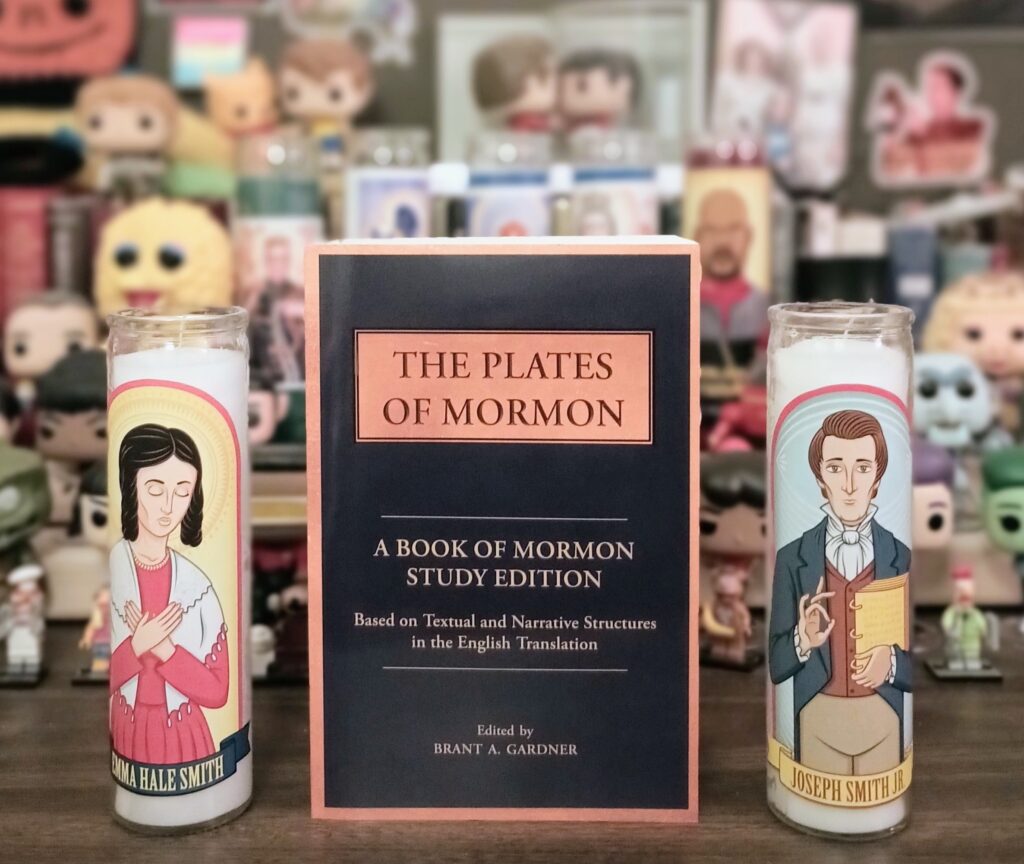Review
———
Title: The Plates of Mormon: A Book of Mormon Study Edition: Based on Textual and Narrative Structures in the English Translation
Author: Brant A. Gardner
Publisher: Greg Kofford Books
Genre: Mormon Studies
Year Published: 2023
Number of Pages: 575
Binding: Paperback
ISBN10: 1589587766
ISBN13: 978-1589587762
Price: $34.95
Reviewed by Ian T. Davidson for the Association for Mormon Letters
The Plates of Mormon is another worthwhile study edition of The Book of Mormon to be published in recent years. Unlike many other study editions, The Plates of Mormon primarily uses the published transcript of the Printer’s Manuscript and, where possible, the Original Manuscript as compiled and digitized by the Joseph Smith Papers Project. Where Plates differs significantly from other recently published study or reader’s editions of The Book of Mormon is that Gardner did not use the punctuation that has become standard over many publications of The Book of Mormon. Gardner took on anew the task of the Grandin Press’s compositor and typesetter, which had to add punctuation and paragraphs. Instead of relying on the punctuation and paragraphing of the printer, Gardner’s Plates undertakes the impossible feat of using new punctuation to recreate the original meaning of the plates compiled by Mormon.
Any attempt to change punctuation in scripture, no matter how obvious, is a fraught endeavor. Changes in punctuation can change the meaning of the text in sometimes significant ways (e.g. “let’s eat grandma” instead of “let’s eat, Grandma”). Because many would-be readers of Plates are so familiar with the modern version of the shared source text, this volume may be unwelcome to some.
Gardner’s footnotes are insightful though they sometimes come across as the work of a college professor grading a paper, such as when he notes there is an “incomplete sentence” in Alma 10:31. Other footnotes are not as useful as they could be. For example, Korihor is referred to as an “Anti-Christ” in most editions of The Book of Mormon, adopting the spelling used in the New Testament. Gardner’s Plates, however, renders it as “anti Christ,” a description rather than a title, which the full context of the scripture supports. The footnote, however, does not note that the Printer’s Manuscript is written as “Anti Christ,” an option neither presentation reflects. An extra sentence noting the difference and acknowledging nonstandard capitalization in the footnote would have been beneficial to readers.
For a deeper dive into the reasoning for Gardner’s decisions, the reader will need to consult chapter seven of his companion book, Engraven Upon Plates, Printed Upon Paper: Textual and Narrative Structures of the Book of Mormon. Like many other recent study editions of The Book of Mormon, Gardner’s editorial choices on how to present the text invite students of the scripture to look at a well-read book with new eyes. As Gardner notes in his introduction to Plates, “Reading the two books together provides the undergirding principles for the editorial decisions that are embodied here. Each book is also able to stand alone.”
Gardner, as editor, had to make some decisions about how best to present the text of The Book of Mormon in his Plates. The most notable difference to most readers will be a change in the order of the books since the first seven books within The Book of Mormon, 1 Nephi to Words of Mormon, appear at the end in order to match the order in which they were translated. Choices like this, as well as choices to make modern versification visually less prominent, which is common in modern study Bibles and recent study editions of The Book of Mormon, may be an obstacle too large for readers who have only ever engaged with the text in the two-column versified format common to members of The Church of Jesus Christ of Latter-day Saints. As a result, this study version of the Latter-day Saints scripture may be inaccessible to most lay readers of the scripture. For scholars or believers more familiar with study or annotated versions of scripture, this new addition will be welcome. For readers who own multiple study editions of The Book of Mormon, comparing the different editions may be particularly enlightening.

